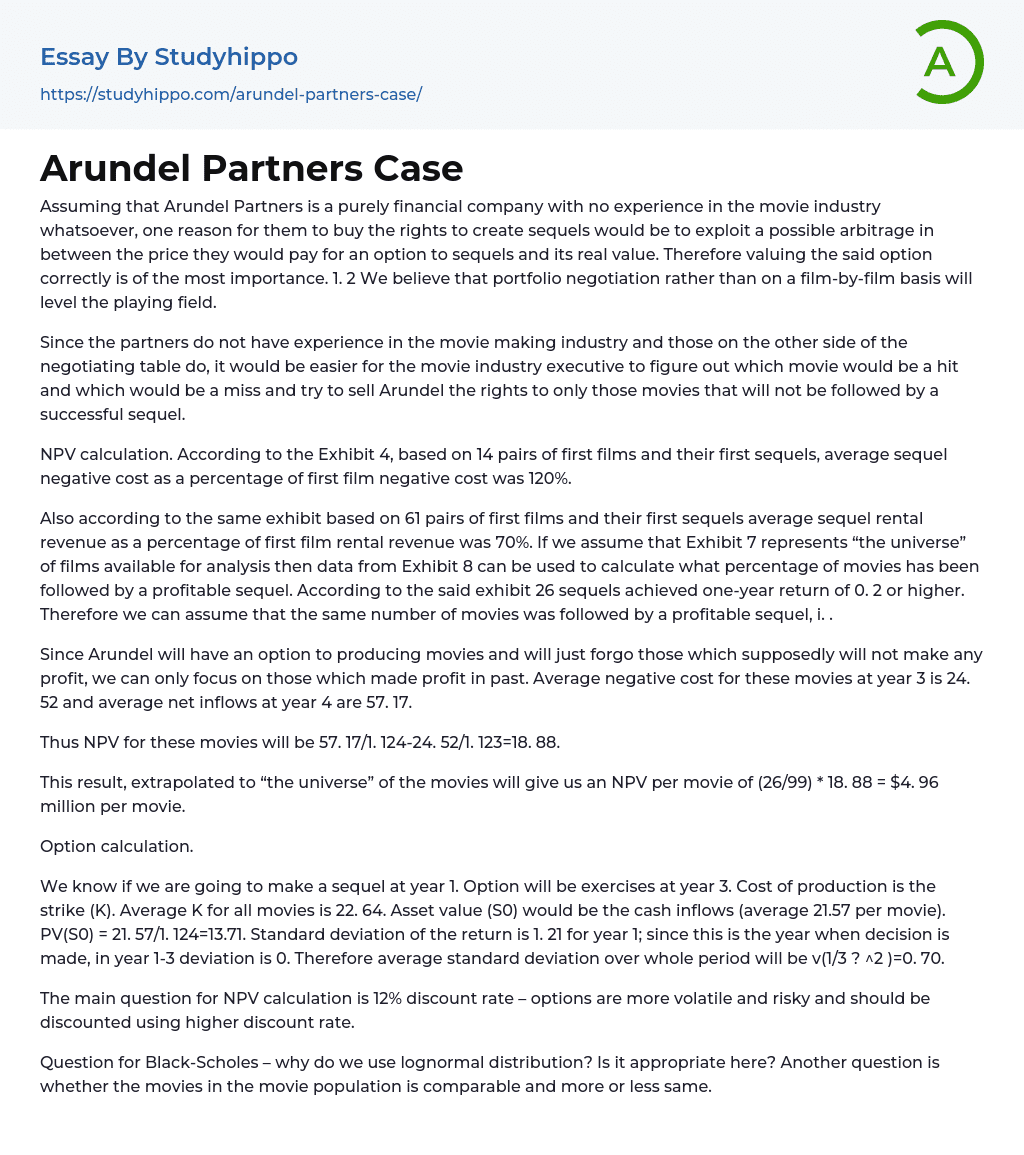Assuming that Arundel Partners is a purely financial company with no experience in the movie industry whatsoever, one reason for them to buy the rights to create sequels would be to exploit a possible arbitrage in between the price they would pay for an option to sequels and its real value. Therefore valuing the said option correctly is of the most importance. 1. 2 We believe that portfolio negotiation rather than on a film-by-film basis will level the playing field.
Since the partners do not have experience in the movie making industry and those on the other side of the negotiating table do, it would be easier for the movie industry executive to figure out which movie would be a hit and which would be a miss and try to sell Arundel the rights to only those movies that will not be fo
...llowed by a successful sequel.
NPV calculation. According to the Exhibit 4, based on 14 pairs of first films and their first sequels, average sequel negative cost as a percentage of first film negative cost was 120%.
Also according to the same exhibit based on 61 pairs of first films and their first sequels average sequel rental revenue as a percentage of first film rental revenue was 70%. If we assume that Exhibit 7 represents “the universe” of films available for analysis then data from Exhibit 8 can be used to calculate what percentage of movies has been followed by a profitable sequel. According to the said exhibit 26 sequels achieved one-year return of 0. 2 or higher. Therefore we can assume that the same number of movies was followed by a profitable sequel, i. .
Since
Arundel will have an option to producing movies and will just forgo those which supposedly will not make any profit, we can only focus on those which made profit in past. Average negative cost for these movies at year 3 is 24. 52 and average net inflows at year 4 are 57. 17.
Thus NPV for these movies will be 57. 17/1. 124-24. 52/1. 123=18. 88.
This result, extrapolated to “the universe” of the movies will give us an NPV per movie of (26/99) * 18. 88 = $4. 96 million per movie.
Option calculation.
We know if we are going to make a sequel at year 1. Option will be exercises at year 3. Cost of production is the strike (K). Average K for all movies is 22. 64. Asset value (S0) would be the cash inflows (average 21.57 per movie). PV(S0) = 21. 57/1. 124=13.71. Standard deviation of the return is 1. 21 for year 1; since this is the year when decision is made, in year 1-3 deviation is 0. Therefore average standard deviation over whole period will be v(1/3 ? ^2 )=0. 70.
The main question for NPV calculation is 12% discount rate – options are more volatile and risky and should be discounted using higher discount rate.
Question for Black-Scholes – why do we use lognormal distribution? Is it appropriate here? Another question is whether the movies in the movie population is comparable and more or less same.
- Wall Street essays
- Dead Poets Society essays
- A beautiful mind essays
- Sherlock Holmes essays
- Our day out essays
- American Beauty essays
- Do The Right Thing essays
- Forrest Gump essays
- Good Will Hunting essays
- Finding Forrester essays
- Looking For Alibrandi essays
- On The Waterfront essays
- One Flew Over The Cuckoo'S Nest essays
- Rabbit Proof Fence essays
- Remember The Titans essays
- Schindler'S List essays
- Shawshank Redemption essays
- The Blind Side essays
- Titanic essays
- Witness essays
- The Veil essays
- Blade Runner essays
- Monster essays
- The Graduate essays
- Twilight essays
- West Side Story essays
- Like Water For Chocolate essays
- Glory essays
- Superman essays
- Moulin rouge essays
- American Films essays
- Cinema Of The United States essays
- English-Language Films essays
- Film Editing essays
- Film Noir essays
- Film Techniques essays
- Horror essays
- Bollywood essays
- The time essays
- Saving private ryan essays
- The hunger games essays
- Comedies essays
- Gattaca essays
- King kong essays
- Melodrama essays
- Resident essays
- Subject matter essays
- The blind essays
- The corner essays
- The godfather essays




